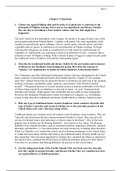Case
Activity 12
1. Choose one typical Filipino dish and describe it. Explain how it conforms to the principles of Filipino cooking. Select one or two ingredients and discuss whether they are due to an influence from another culture and why that might have happened. The dish I chose for this description is the Lum...
[Show more]



